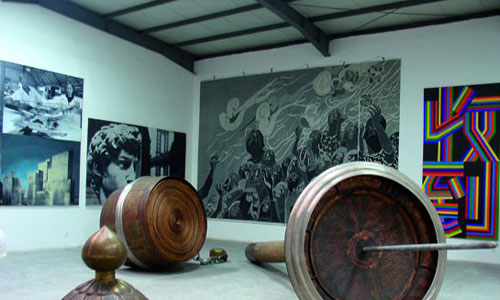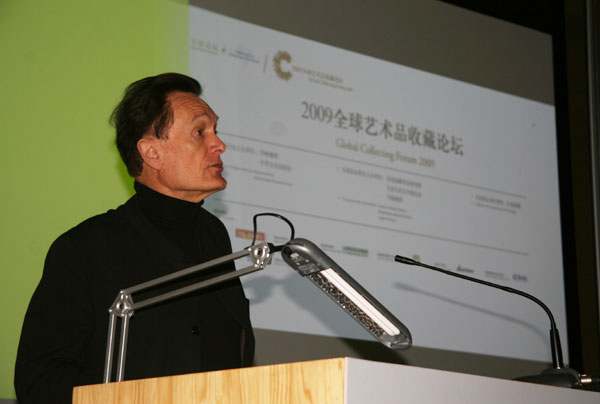Where is China's contemporary art?
 |
|
Huang Yongping's work "Wong Ma Mi Ba Ni Hong". An exhibition of 30 Chinese artists opens with the Global Collecting Forum to show the situation of China's contemporary art. Huang is one of them. [people.com.cn/China.org.cn] |
"Chinese museums that want to showcase domestic contemporary art of the 1980s and '90s may have to borrow exhibits from abroad." This was the view of the late prominent Chinese painter Chen Yifei.
Chen was not the only one to voice concern. Reputed art critic and curator Gao Minglu was quoted in the Beijing Star Daily as complaining that it is difficult for curators in China to put together a retrospective exhibition of contemporary Chinese art, because so many representative works of the 1980s cannot even be found in the country.
In March 2006, the New York branch of the auction house Sotheby's successfully held its inaugural auction of Asian contemporary art, where the majority of items were created by Chinese artists. The event was viewed as the turning point for Chinese contemporary art in the international arena. Since then, many works of Chinese contemporary art were snapped up by foreign buyers.
As a result, a remarkable number of Chinese contemporary artworks now reside in Western art galleries or the homes of Western individual collectors such as Swiss native Uli Sigg, who is reputed to hold the largest private collection of Chinese contemporary art in the world. From paintings and sculptures to videos and installations, Mr. Sigg has acquired and preserved around 2,000 pieces of art since 1985, when China's contemporary art was still in its infancy.
Historically, China has never lacked devoted art lovers such as Mr. Sigg. However, most collectors prefer traditional art rather than the contemporary. Antiques have always been a major contributor to China's auction sales. A 2008-2009 report on China's auction market, released by the Chinese Modern and Contemporary Art Document Research Center, shows that more than 85 percent of total sales were generated by works of traditional and fine arts such as ceramics and calligraphy.
Among those Chinese who do purchase contemporary art, many are investors or speculators who simply buy art to sell at a later date for profit. On top of this, Chinese museums and art institutions are yet to focus on contemporary art, according to Wang Huangsheng, director of the Art Museum of China Central Academy of Fine Arts.
"Major museums in China are still focused largely on modern art as opposed to contemporary... and their collections rely largely on donations from artists or their relations," Wang said recently at the Global Collecting Forum, which for the first time gathered the world's top institutional and private collectors in Beijing. According to Wang, although some museums have agendas for contemporary art, a small budget and an incomplete art preservation system are two major obstacles for Chinese museums in acquiring contemporary art. Wang calls on Chinese art museums to expand their financial resources, and make long-term and systematic collecting agendas.
|
Martin Kemp, art historian and Emeritus Professor in the History of Art at Oxford University, gives a speech at the Global Collecting Forum on October 11, 2009 in Beijing. [CRI] |
During the Global Collecting Forum, representatives of Western museums and art institutions offered advice to their Chinese counterparts. Among them was Gary Tinterow from New York's Metropolitan Museum of Art. The Met, as it is better known, is one of the world's largest and most important art museums. Its permanent collection contains two million works of art divided into 22 curatorial departments. Tinterow's advice to galleries in China "simply would be to first understand what the goal of your collection is. Among the questions [you should ask yourself] are why do you collect? Is it to support the work of the artists? Do you want to attract a specific audience? Or do you want to create a collection of masterpieces?" Tinterow notes that museums and art institutions should first identify their collecting type, and adopt relevant strategies accordingly.
|
Nick Simunovic (right), director of Gagosian Gallery Hong Kong, gives a speech at the Global Collecting Forum on October 11, 2009 in Beijing. [CRI] |
Museums aside, individual collectors also play a crucial role in art preservation. But contemporary art, often avant-garde and transgressive, is still seen as strange and unfathomable to the Chinese public. Derek Gillman, executive director and president of the American-based Barnes Foundation, thinks it's critical to bring contemporary art to the general public.
In the 1920s, Albert C. Barnes founded his educational art institution and museum, which is now the world's top collector of Post-Impressionist paintings. Gillman explains, "When Barnes showed part of his collection in 1923, the response was absolutely hostile. The work was regarded as disgusting, immoral, crude and disgraceful." However, "Barnes thought that he could use his collection to show young American painters what great contemporary art was... he wanted to explain to his public why contemporary art wasn't immortal and why it was interesting, and that was a major part of his agenda."
Experts at the forum believe it's the responsibility of art museums and institutions to help the general public understand contemporary art, and by cultivating a wider social interest, motivate the public to become collectors.
Uli Sigg, the Swiss collector of Chinese contemporary art, has said he will probably bring his collection back to China eventually ("In the end, it would make sense for the Chinese people to see their own art."). Hopefully by then, Chinese museums and private collectors will be ready to include those artworks in their permanent collections.
 0
0 








